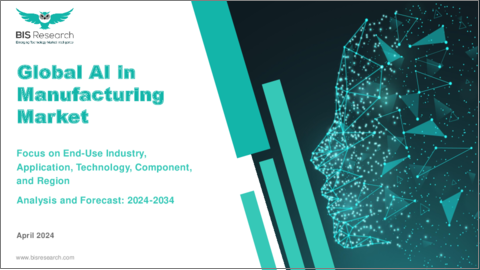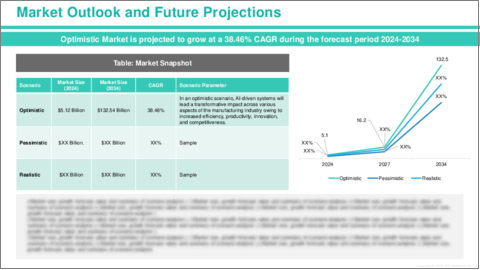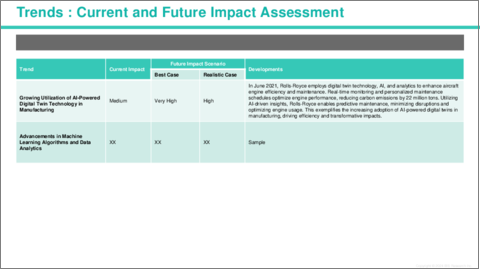|
|
市場調査レポート
商品コード
1470377
製造業向けAIの世界市場:エンドユーザー産業・用途・技術・コンポーネント・地域別:分析と予測(2024年~2034年)Global AI in Manufacturing Market: Focus on End-Use Industry, Application, Technology, Component, and Region - Analysis and Forecast, 2024-2034 |
||||||
カスタマイズ可能
|
|||||||
| 製造業向けAIの世界市場:エンドユーザー産業・用途・技術・コンポーネント・地域別:分析と予測(2024年~2034年) |
|
出版日: 2024年04月26日
発行: BIS Research
ページ情報: 英文 100 Pages
納期: 1~5営業日
|
- 全表示
- 概要
- 目次
AIは、生産性、効率性、データ主導の意思決定を後押しすることで、製造業の展望を再構築しています。
AIを搭載したロボットによる作業の自動化は、業務を合理化するだけでなく、職場の安全性を高めます。人の労働力をより複雑な作業に集中させることで、AIは急速に進化する世界市場での競争力を維持し、より機敏で対応力のある産業への道を開いています。
楽観的シナリオでは、2024年の市場規模は51億2,000万米ドルを示し、CAGR 38.46%で推移し、2034年には1,325億4,000万米ドルの規模に成長すると予測されています。この成長動向の主な要因は、ますます複雑化するデータセットを管理する必要性と、製造部門における機械学習アルゴリズムとデータアナリティクスの進歩です。
| 主要市場統計 | |
|---|---|
| 予測期間 | 2024-2034年 |
| 2024年評価額 | 51億2,000万米ドル |
| 2034年予測 | 1,325億4,000万米ドル |
| CAGR | 38.46% |
こうした市場促進要因にもかかわらず、市場は、特に新興国において能力のある人材の確保などの障壁に直面しています。しかし、スマートな業務プロセスのためにAI、機械学習、自然言語処理 (NLP) を活用することは、製造業向けAIの拡大に有利な機会をもたらします。AIとビッグデータアナリティクスにより、企業は多様なソースからの広範な構造化・非構造化データを迅速に分析できます。これにより、企業は異常を特定し、保守費用を削減し、顧客サービスを強化し、予知・予防保守対策を実施し、情報に基づいた意思決定のために生データを活用することができます。
北米地域の製造業向けAI市場は大きな成長を遂げています。米国、カナダ、メキシコを含む北米地域の多くの国では、AIの導入を促進するための政策やインセンティブを実施しています。これらの政策には通常、排出量の削減と持続可能な輸送ソリューションの促進を目的とした補助金、税制優遇措置、規制措置が含まれます。この地域の製造業向けAI情勢はダイナミックで、新興企業、研究イニシアティブ、業界リーダー間の戦略的提携が混在しています。北米が現在の市場をリードしている一方、予測期間中はアジア太平洋地域が大幅な成長を遂げようとしています。この成長は、さまざまな製造業でAI技術が急速に受け入れられ、統合され、業務効率の向上と革新的な進歩につながっていることが背景にあります。
当レポートでは、世界の製造業向けAIの市場を調査し、業界の動向、法規制環境、使用事例、市場規模の推移・予測、各種区分・地域/主要国別の詳細分析、競合情勢、主要企業のプロファイルなどをまとめています。
目次
エグゼクティブサマリー
第1章 市場:業界の展望
- 動向:現在および将来の影響評価
- サプライチェーンの概要
- バリューチェーン分析
- 価格予測
- 規制状況
- ステークホルダー分析
- 使用事例
- エンドユーザーと購入基準
- 主要な世界的イベントの影響分析
- 市場力学の概要
- 市場促進要因
- 市場抑制要因
- 市場機会
第2章 製造業向けAI市場:用途別
- 用途の分類
- 用途の概要
- 製造業向けAI市場:エンドユーザー産業別
- 自動車
- 医療機器
- エレクトロニクス
- エネルギー・電力
- 重金属・機械製造
- 航空宇宙・防衛
- その他
- 製造業向けAI市場:用途別
- 組立/品質試験
- 製品開発・エンジニアリング
- 調達
- 注文管理
- メンテナンス
- 物流・在庫管理
- その他
第3章 製造業向けAI市場:製品別
- 製品の分類
- 製品概要
- 製造業向けAI市場:コンポーネント別
- ソフトウェア
- ハードウェア
- サービス
- 製造業向けAI市場:技術別
- 機械学習
- コンピュータビジョン
- 自然言語処理 (NLP)
- その他
第4章 製造業向けAI市場:地域別
- 製造業向けAI市場:地域別
- 北米
- 欧州
- アジア太平洋
- その他の地域
第5章 企業プロファイル
- 次なるフロンティア
- 地理的評価
- Nvidia Corporation
- IBM
- Intel Corporation
- Siemens
- GENERAL ELECTRIC
- Google LLC
- Microsoft
- Micron Technology, Inc.
- Sight Machine
- Oracle
- Cisco Systems, Inc.
- SAP
- Bright Machines, Inc.
- Mitsubishi Electric Corporation
- General Vision Inc.
- その他
第6章 調査手法
Introduction to the AI in Manufacturing Market
AI is reshaping the manufacturing landscape by boosting productivity, efficiency, and data-driven decision-making. Automation of tasks through AI-powered robots not only streamlines operations but also enhances workplace safety. By freeing up human workers to focus on more complex activities, AI enables manufacturers to stay competitive in a rapidly evolving global market, paving the way for a more agile and responsive industry. Considering the optimistic scenario, the market is valued at $5.12 billion in 2024 and is expected to grow at a CAGR of 38.46% to reach $132.54 billion by 2034. The growth trend is chiefly driven by the requirement to manage increasingly intricate datasets and the advancements in machine learning algorithms and data analytics within the manufacturing sector.
| KEY MARKET STATISTICS | |
|---|---|
| Forecast Period | 2024 - 2034 |
| 2024 Evaluation | $5.12 Billion |
| 2034 Forecast | $132.54 Billion |
| CAGR | 38.46% |
Despite these positive drivers, the market faces hurdles such as skilled workforce availability, particularly in developing nations. However, leveraging AI, machine learning, and natural language processing (NLP) for smart enterprise processes presents lucrative opportunities for the expansion of AI in manufacturing sector. With AI and big data analytics, companies can swiftly analyze extensive structured and unstructured data from diverse sources. This enables them to identify anomalies, reduce maintenance expenses, enhance customer service, implement predictive and preventive maintenance measures, and leverage raw data for informed decision-making.
The AI in manufacturing market in the North America region is experiencing significant growth. Many countries in the North America region, including the U.S., Canada, and Mexico, have implemented policies and incentives to promote the adoption of AI. These policies typically include subsidies, tax incentives, and regulatory measures aimed at reducing emissions and promoting sustainable transportation solutions. The region's AI in manufacturing landscape is dynamic, featuring a mix of startups, research initiatives, and strategic collaborations among industry leaders. Currently, North America is leading the market. However, during the forecast period, the Asia-Pacific region is poised for substantial growth in the AI in manufacturing market. This growth is fueled by the rapid acceptance and integration of AI technologies across various manufacturing industries, leading to enhanced operational efficiency and innovative advancements.
Leading companies such as NVIDIA Corporation, IBM, and Intel Corporation are pioneering the way forward, providing a comprehensive array of AI products encompassing software, hardware, machine learning, computer vision, and natural language processing. The companies utilize AI to revolutionize manufacturing through solutions such as NVIDIA Metropolis, Isaac Sim, IBM's generative AI, and Intel's semiconductor optimization, enhancing efficiency and enabling data-driven decision-making. They also invest heavily in research and development to innovate new products.
Market Segmentation:
Segmentation 1: by End-Use Industry
- Automotive
- Medical Devices
- Electronics
- Energy and Power
- Heavy Metals and Machine Manufacturing
- Aerospace and Defense
- Others
Segmentation 2: by Application
- Assembly/Quality Testing
- Product Development and Engineering
- Procurement
- Order Management
- Maintenance
- Logistics and Inventory Management
- Others
Segmentation 3: by Component
- Software
- Hardware
- Service
Segmentation 4: by Technology
- Machine Learning
- Computer Vision
- Natural Language Processing (NLP)
- Others
Segmentation 5: by Region
- North America
- Europe
- Asia-Pacific
- Rest-of-the-World
Key Market Players and Competition Synopsis
The companies that are profiled in the global AI in manufacturing market have been selected based on input gathered from primary experts and analyzing company coverage, product portfolio, and market penetration.
Some of the prominent companies in this market are:
- IBM
- Microsoft
- Siemens
- Nvidia Corporation
- Google LLC
Key Questions Answered in this Report:
- What are the main factors driving the demand for AI in manufacturing markets?
- What are the major patents filed by the companies active in the AI in manufacturing markets?
- Who are the key players in the AI in manufacturing markets, and what are their respective market shares?
- What partnerships or collaborations are prominent among stakeholders in the AI in manufacturing markets?
- What are the strategies adopted by the key companies to gain a competitive edge in AI in manufacturing markets?
- What is the futuristic outlook for the AI in manufacturing markets in terms of growth potential?
- What is the current estimation of the AI in manufacturing markets, and what growth trajectory is projected from 2024 to 2034?
- Which application, and product segment is expected to lead the market over the forecast period (2024-2034)?
- What could be the impact of growing end-use industries in the AI in manufacturing markets?
- Which regions demonstrate the highest adoption rates for AI in manufacturing markets, and what factors contribute to their leadership?
Table of Contents
Executive Summary
Scope and Definition
Market/Product Definition
Key Questions Answered
Analysis and Forecast Note
1. Markets: Industry Outlook
- 1.1 Trends: Current and Future Impact Assessment
- 1.2 Supply Chain Overview
- 1.2.1 Value Chain Analysis
- 1.2.2 Pricing Forecast
- 1.3 Regulatory Landscape
- 1.4 Stakeholder Analysis
- 1.4.1 Use Case
- 1.4.2 End User and Buying Criteria
- 1.5 Impact Analysis for Key Global Events
- 1.6 Market Dynamics Overview
- 1.6.1 Market Drivers
- 1.6.2 Market Restraints
- 1.6.3 Market Opportunities
2. AI in Manufacturing (by Application)
- 2.1 Application Segmentation
- 2.2 Application Summary
- 2.3 AI in Manufacturing Market (by End-Use Industry)
- 2.3.1 Automotive
- 2.3.2 Medical Devices
- 2.3.3 Electronics
- 2.3.4 Energy & Power
- 2.3.5 Heavy Metals & Machine Manufacturing
- 2.3.6 Aerospace & Defence
- 2.3.7 Others
- 2.4 AI in Manufacturing Market (by Application)
- 2.4.1 Assembly/Quality Testing
- 2.4.2 Product Development & Engineering
- 2.4.3 Procurement
- 2.4.4 Order Management
- 2.4.5 Maintenance
- 2.4.6 Logistics and Inventory Management
- 2.4.7 Others
3. AI in Manufacturing (by Product)
- 3.1 Product Segmentation
- 3.2 Product Summary
- 3.3 AI in Manufacturing (by Component)
- 3.3.1 Software
- 3.3.2 Hardware
- 3.3.3 Service
- 3.4 AI in Manufacturing (by Technology)
- 3.4.1 Machine Learning
- 3.4.2 Computer Vision
- 3.4.3 Natural Language Processing (NLP)
- 3.4.4 Others
4. Global AI in Manufacturing (by Region)
- 4.1 AI in Manufacturing (by Region)
- 4.2 North America
- 4.2.1 Regional Overview
- 4.2.2 Driving Factors for Market Growth
- 4.2.3 Factors Challenging the Market
- 4.2.4 Application
- 4.2.5 Product
- 4.2.6 U.S.
- 4.2.6.1 Market by Application
- 4.2.6.2 Market by Product
- 4.2.7 Canada
- 4.2.7.1 Market by Application
- 4.2.7.2 Market by Product
- 4.2.8 Mexico
- 4.2.8.1 Market by Application
- 4.2.8.2 Market by Product
- 4.3 Europe
- 4.3.1 Regional Overview
- 4.3.2 Driving Factors for Market Growth
- 4.3.3 Factors Challenging the Market
- 4.3.4 Application
- 4.3.5 Product
- 4.3.6 Germany
- 4.3.6.1 Market by Application
- 4.3.6.2 Market by Product
- 4.3.7 France
- 4.3.7.1 Market by Application
- 4.3.7.2 Market by Product
- 4.3.8 U.K.
- 4.3.8.1 Market by Application
- 4.3.8.2 Market by Product
- 4.3.9 Italy
- 4.3.9.1 Market by Application
- 4.3.9.2 Market by Product
- 4.3.10 Rest-of-Europe
- 4.3.10.1 Market by Application
- 4.3.10.2 Market by Product
- 4.4 Asia-Pacific
- 4.4.1 Regional Overview
- 4.4.2 Driving Factors for Market Growth
- 4.4.3 Factors Challenging the Market
- 4.4.4 Application
- 4.4.5 Product
- 4.4.6 China
- 4.4.6.1 Market by Application
- 4.4.6.2 Market by Product
- 4.4.7 Japan
- 4.4.7.1 Market by Application
- 4.4.7.2 Market by Product
- 4.4.8 India
- 4.4.8.1 Market by Application
- 4.4.8.2 Market by Product
- 4.4.9 South Korea
- 4.4.9.1 Market by Application
- 4.4.9.2 Market by Product
- 4.4.10 Rest-of-Asia-Pacific
- 4.4.10.1 Market by Application
- 4.4.10.2 Market by Product
- 4.5 Rest-of-the-World
- 4.5.1 Regional Overview
- 4.5.2 Driving Factors for Market Growth
- 4.5.3 Factors Challenging the Market
- 4.5.4 Application
- 4.5.5 Product
- 4.5.6 South America
- 4.5.6.1 Market by Application
- 4.5.6.2 Market by Product
- 4.5.7 Middle East and Africa
- 4.5.7.1 Market by Application
- 4.5.7.2 Market by Product
5. Companies Profiled
- 5.1 Next Frontiers
- 5.2 Geographic Assessment
- 5.2.1 Nvidia Corporation
- 5.2.1.1 Overview
- 5.2.1.2 Top Products/Product Portfolio
- 5.2.1.3 Top Competitors
- 5.2.1.4 Target Customers
- 5.2.1.5 Key Personnel
- 5.2.1.6 Analyst View
- 5.2.1.7 Market Share
- 5.2.2 IBM
- 5.2.2.1 Overview
- 5.2.2.2 Top Products/Product Portfolio
- 5.2.2.3 Top Competitors
- 5.2.2.4 Target Customers
- 5.2.2.5 Key Personnel
- 5.2.2.6 Analyst View
- 5.2.2.7 Market Share
- 5.2.3 Intel Corporation
- 5.2.3.1 Overview
- 5.2.3.2 Top Products/Product Portfolio
- 5.2.3.3 Top Competitors
- 5.2.3.4 Target Customers
- 5.2.3.5 Key Personnel
- 5.2.3.6 Analyst View
- 5.2.3.7 Market Share
- 5.2.4 Siemens
- 5.2.4.1 Overview
- 5.2.4.2 Top Products/Product Portfolio
- 5.2.4.3 Top Competitors
- 5.2.4.4 Target Customers
- 5.2.4.5 Key Personnel
- 5.2.4.6 Analyst View
- 5.2.4.7 Market Share
- 5.2.5 GENERAL ELECTRIC
- 5.2.5.1 Overview
- 5.2.5.2 Top Products/Product Portfolio
- 5.2.5.3 Top Competitors
- 5.2.5.4 Target Customers
- 5.2.5.5 Key Personnel
- 5.2.5.6 Analyst View
- 5.2.5.7 Market Share
- 5.2.6 Google LLC
- 5.2.6.1 Overview
- 5.2.6.2 Top Products/Product Portfolio
- 5.2.6.3 Top Competitors
- 5.2.6.4 Target Customers
- 5.2.6.5 Key Personnel
- 5.2.6.6 Analyst View
- 5.2.6.7 Market Share
- 5.2.7 Microsoft
- 5.2.7.1 Overview
- 5.2.7.2 Top Products/Product Portfolio
- 5.2.7.3 Top Competitors
- 5.2.7.4 Target Customers
- 5.2.7.5 Key Personnel
- 5.2.7.6 Analyst View
- 5.2.7.7 Market Share
- 5.2.8 Micron Technology, Inc.
- 5.2.8.1 Overview
- 5.2.8.2 Top Products/Product Portfolio
- 5.2.8.3 Top Competitors
- 5.2.8.4 Target Customers
- 5.2.8.5 Key Personnel
- 5.2.8.6 Analyst View
- 5.2.8.7 Market Share
- 5.2.9 Sight Machine
- 5.2.9.1 Overview
- 5.2.9.2 Top Products/Product Portfolio
- 5.2.9.3 Top Competitors
- 5.2.9.4 Target Customers
- 5.2.9.5 Key Personnel
- 5.2.9.6 Analyst View
- 5.2.9.7 Market Share
- 5.2.10 Oracle
- 5.2.10.1 Overview
- 5.2.10.2 Top Products/Product Portfolio
- 5.2.10.3 Top Competitors
- 5.2.10.4 Target Customers
- 5.2.10.5 Key Personnel
- 5.2.10.6 Analyst View
- 5.2.10.7 Market Share
- 5.2.11 Cisco Systems, Inc.
- 5.2.11.1 Overview
- 5.2.11.2 Top Products/Product Portfolio
- 5.2.11.3 Top Competitors
- 5.2.11.4 Target Customers
- 5.2.11.5 Key Personnel
- 5.2.11.6 Analyst View
- 5.2.11.7 Market Share
- 5.2.12 SAP
- 5.2.12.1 Overview
- 5.2.12.2 Top Products/Product Portfolio
- 5.2.12.3 Top Competitors
- 5.2.12.4 Target Customers
- 5.2.12.5 Key Personnel
- 5.2.12.6 Analyst View
- 5.2.12.7 Market Share
- 5.2.13 Bright Machines, Inc.
- 5.2.13.1 Overview
- 5.2.13.2 Top Products/Product Portfolio
- 5.2.13.3 Top Competitors
- 5.2.13.4 Target Customers
- 5.2.13.5 Key Personnel
- 5.2.13.6 Analyst View
- 5.2.13.7 Market Share
- 5.2.14 Mitsubishi Electric Corporation
- 5.2.14.1 Overview
- 5.2.14.2 Top Products/Product Portfolio
- 5.2.14.3 Top Competitors
- 5.2.14.4 Target Customers
- 5.2.14.5 Key Personnel
- 5.2.14.6 Analyst View
- 5.2.14.7 Market Share
- 5.2.15 General Vision Inc.
- 5.2.15.1 Overview
- 5.2.15.2 Top Products/Product Portfolio
- 5.2.15.3 Top Competitors
- 5.2.15.4 Target Customers
- 5.2.15.5 Key Personnel
- 5.2.15.6 Analyst View
- 5.2.15.7 Market Share
- 5.2.16 Others
- 5.2.1 Nvidia Corporation






